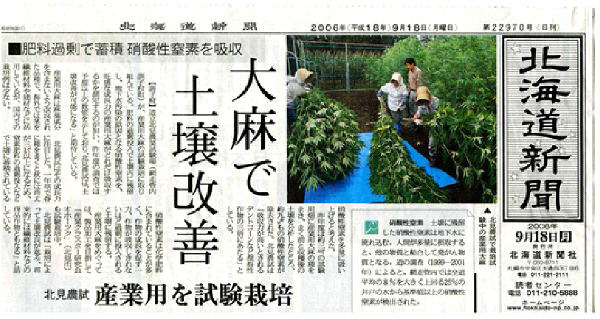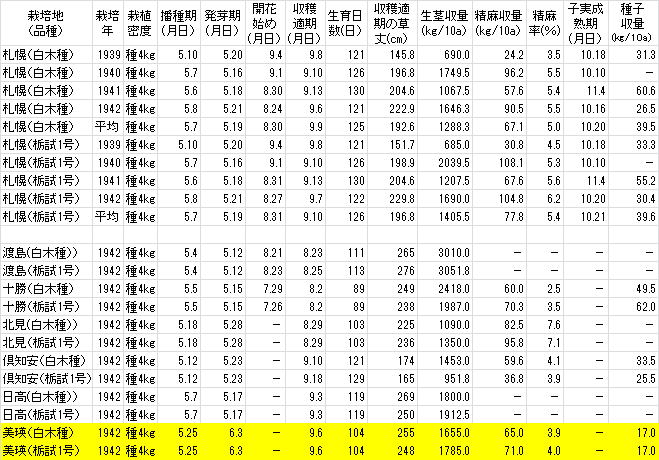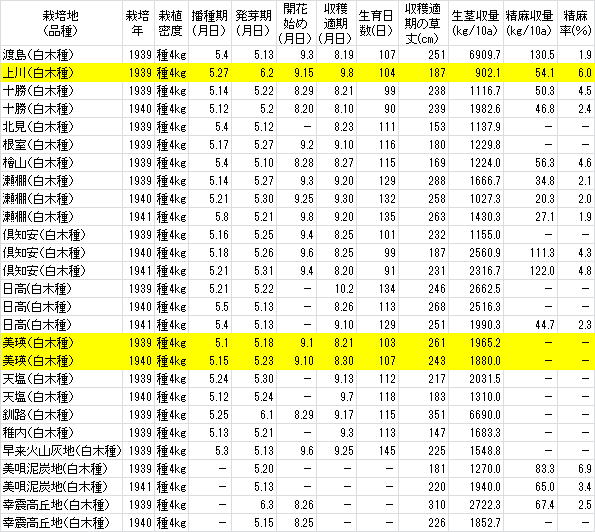Industrial hemp of Hokkaido -the challenge towards a future-
Study of Kitami Agricultural Experiment Station 2005 - 2008

Soil Improvement With Hemp
The Hokkaido Kitami Agricultural Experiment Station is engaged in trial growth of industrial hemp. The aim is to measure the extent to which rapidly growing industrial hemp absorbs nitrate nitrogen residue in the soil from excess fertilizer use, which causes underground water contamination. Tests last year showed higher readings than expected, and Kitami Agricultural hopes that "soil improvement will become a possibility".
Breeds of industrial hemp are refined so as not to contain narcotic components. The stalks are used abroad in textiles and building materials, but it is not commonly grown domestically. Kitami Agricultural was drawn by this annual plant's growth. Seeds sown in the spring reach a height of over 3m in the autumn, so they thought it would take in large amounts of the nitrate nitrogen that accumulates in soil due to overuse of nitrogenous fertilizers and so on.
Last year, about 300m² of test fields were sown with industrial hemp, with the soil analyzed both before sowing and just after harvest, and around 9kg of nitrate nitrogen was removed. Kitami Agricultural states that "it has 3 times the absorbency power of deep rooted crops like dent corn, that are regarded as highly absorbent." Nitrate nitrogen is contained in many chemical fertilizers, and while it does stimulate crop growth, it is overused in amounts that cannot be absorbed by the crops, and remains in the soil.
The Okhotsk Institute of Industrial Cluster (Kitami city) is also growing industrial hemp in trials aimed at product manufacture. Kitami Agricultural states that "as soil improvement progresses due to its growth, it will become a future commercial crop for textiles and so on."
Nitrate nitrogen
Nitrate nitrogen residues in soil seep into underground water. When humans absorb large quantities, it combines with other materials to form carcinogens. According to a test in Hokkaido (1999-2001), higher than average values of nitrate nitrogen (25%) were found in well water from Abashiri, greatly exceeding the average of 8% for all of Hokkaido.
<Source: September 18, 2006 From the Hokkaido Shimbun Press>
This study was conducted over the four years from 2005 to 2008, and the following reports have been issued. For details please download PDF and read.
(Japanese only)
Measures to reduce contamination by introducing deep root crops(2009)
http://www.agri.hro.or.jp/center/kankoubutsu/shiryou/38/fulltxtindex.html
Hokkaido agricultural research stations before WWII 1939 - 1942
Several growth studies were carried out at Hokkaido agricultural research
stations before WWII. Due to a study held from 1939-42, a breed called
"Tochishi No. 1", cultivated in 1928 at the Tochigi prefectural
agricultural research station, was designated as an excellent breed for
Hokkaido in 1943.

Hemp cultivation study of 16 locations in Hokkaido

Test cultivation began in Kamikawa from May 2014. It will be test cultivation for the first time in 72 years since the Biei branch of the same Kamikawa.

The picture shows the state when transplanted to the field on May 31, 2014